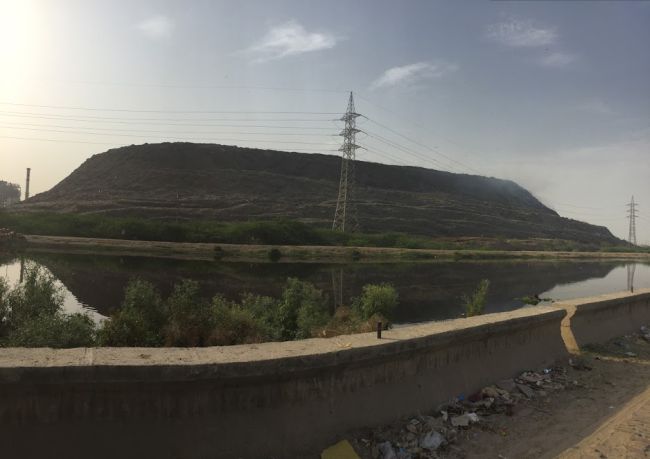New Delhi: Nation’s Capital Delhi is setting the worst possible example when it comes to waste disposal. A ban was imposed on waste dumping at the city’s oldest and largest landfill – Ghazipur, following a man-made tragedy on September 1 that left four cars destroyed and two people dead, when the 80-feet garbage mountain that had been accumulating for decades caved in. Despite the ban, 6,500 tonnes of garbage is still being dumped in the landfill, on a daily basis. This dumping is in defiance of Lieutanant Governor Anil Baijal’s order to stop disposing of waste in Ghazipur after the September 1 incident. The reason for this continued dumping – lack of an alternative to dispose of waste.
Speaking to NDTV, Neema Bhagat, Mayor East Delhi Municipal Corporation (EDMC) added, we are sending 500 metric tonnes to Okhla, 1,300 to waste-to-energy plant at Ghazipur and the rest of 6,500 tonnes is still being dumped at Ghazipur under technical supervision so as to avoid any risk/accident in future.
This essentially means that even after the September 1 tragedy and subsequent ban, Ghazipur continues to bear the brunt of nearly 72% of Delhi’s waste. Ghazipur epitomises the crisis facing not just Delhi but landfills across India. The landfill which became operational in 1984, ran out of capacity in 2002, but continued to be used for waste dumping for next 15 years, long after its lifespan ended. It underlines the negligence with which waste is managed in India for decades. And despite an accident of the kind that Ghazipur witnessed, when the mountain of trash collapsed as it could not bear the burden anymore, very little has changed on the ground at the moment but EDMC assures it has a plan in place.
Ms Bhagat says, the plan is to increase the capacity of our Ghazipur waste-to-energy plant – from 1,300 to 2,000. It will happen in coming months. From November, National Highways Authority (NHAI) officials will start segregating the trash from the site and will use it in the construction of Delhi-Meerut Expressway. With this plan of action, we will clear this site in 2 years’ time.
Why EDMC Failed To Find A Temporary Waste Dumping Site
After Lieutenant Governor Anil Baijal banned garbage dumping at Ghazipur, within hours EDMC had finalised a 50-acre site in Rani Khera located on the Delhi-Haryana border to be used for waste dumpling as an alternative to Ghazipur. But waste disposal couldn’t begin because residents living in nearby areas protested. EDMC then came up with the 150 acre land in Ghonda, however, the Green Court (National Green Tribunal) rejected the proposal on grounds that the site is situated in an environmentally-sensitive zone near the Yamuna river.
The garbage crisis is not just limited to Ghazipur. Currently, be it Bhalswa or Okhla, which are the two other landfills of Delhi are overflowing too. These too have ran out of space nearly a decade ago but are still in use.
The Solution: Delhi Needs To Learn How To Segregate Its Waste
Authorities need to learn that it is just not about finding another landfill sites, the Ghazipur-disaster can be replicated in Okhla, Bhalswa landfill sites too. Civic bodies should come up with waste treatment solutions if they want to avoid these crises. Here’s what experts have to say:
The permanent solution to Delhi’s garbage crisis is waste segregation, unless we learn how to segregate our waste at source, any waste management solution will be a huge fail. Waste segregation is no rocket science, everyone knows what dry waste, and wet waste is. The residents are not segregating because the authorities have not implemented a treatment chain yet. They know even if they will segregate the waste, it will end up in the landfills. Civic bodies need to set up effective collection, transfer and treatment chain, said Satish Sinha, Associate Director of Toxic Links.
Swati Singh Sambyal, Programme Manager at the Centre for Science and Environment highlights the fact that people still think waste segregation is authorities job, she adds, “We need to stop thinking that waste segregation will be done by someone else, it is our duty, if we can generate, we can easily segregate. Waste segregation needs as much importance as brushing our teeth every morning.”
The government made waste segregation mandatory from June 5, 2017, yet, it has failed to take off in Delhi and many other cities of India.
People will learn to segregate waste at source, but, it is the question of enforcement by the civic bodies. Currently, not many steps have been taken to make waste segregation at source mandatory in Delhi, added Satish Sinha.
From Waste Generators To Waste Savers
One cannot just keep on adding waste endlessly on a piece of land, and that’s where waste management game comes in to play.
Every city will need a landfill, but, the onus is on authorities and citizens to make sure that minimum amount of waste ends up going to the landfill. We need recycling, reusing, upcycling solutions for waste, currently most of our waste ends up pilling on just a small piece of land, then obviously it will overflow, added Satish Sinha.
On the other hand, Swati Singh Sambyal, Programme added, “Our landfills are not according to the set Solid Waste Management Rules 2016, so just thinking that having a landfill in the city will solve our waste issues is not right. We definitely need some effective recycling, reusing solutions, otherwise at this pace of garbage generation without segregation and scientific mechanism, India will need landfill the size of Mumbai, Hyderabad, Greater Noida combined by 2047.
Delhi Can Take A Cue From These Cities On How To Manage Waste
We don’t need to look far for some inspiration, there is Alappuzha in Kerala that converts almost its 80 percent of its waste through decentralised composting and biogas units.
Also Read: Tackling Garbage Crisis, The Alappuzha Way: This Kerala City Shows How To Get Rid Of Landfills
Then there is Panjim in Goa that follows waste segregation process into a minimum of five fractions which include one wet waste fraction and four dry waste fractions (plastic, paper/cartons, metal/glass and non-recyclable). The city also converts their trash into compost or biogas and recycles plastic, glass, metals and papers. With strict enforcement, Panjim has achieved 100 per cent success in door-to-door collection of garbage and segregation of garbage at source.
If Delhi needs to fulfill the target of Clean Delhi, apart from getting the open defecation status, it also needs to up its waste management game, only then the city can become fully Swachh.


































Amardeepsharma
September 29, 2017 at 3:58 pm
EVERY DAY WE ARE SEEING GARBAGE DUMPING PROBLEMS BUT NO ONE IS TAKING ANY STEP TOWARDS THIS PROBLEMS.WE HAVE A SOLUTION.
ZERO LANDFILL TECHNOLOGY.AND
SAVE HUGE MONEY ALSO
CAN I PARTICIPATE IN PROGRAMME
NDTV INITIATIVE SWACHH INDIA
ON 2ND OCTOBER 2017.
MK
October 2, 2017 at 11:29 am
Garbage Dumping problem is Rampant every state in India. Huge pile of Garbages are Dumped. This old dumped garbage cannot be incinerated in a professional way?
The new method of segregation is helpful for coming future. We have to do something for the old dumped garbages.
Zero landfill tech I don’t know much but it is good enough for dumped waste most welcome sir
MK